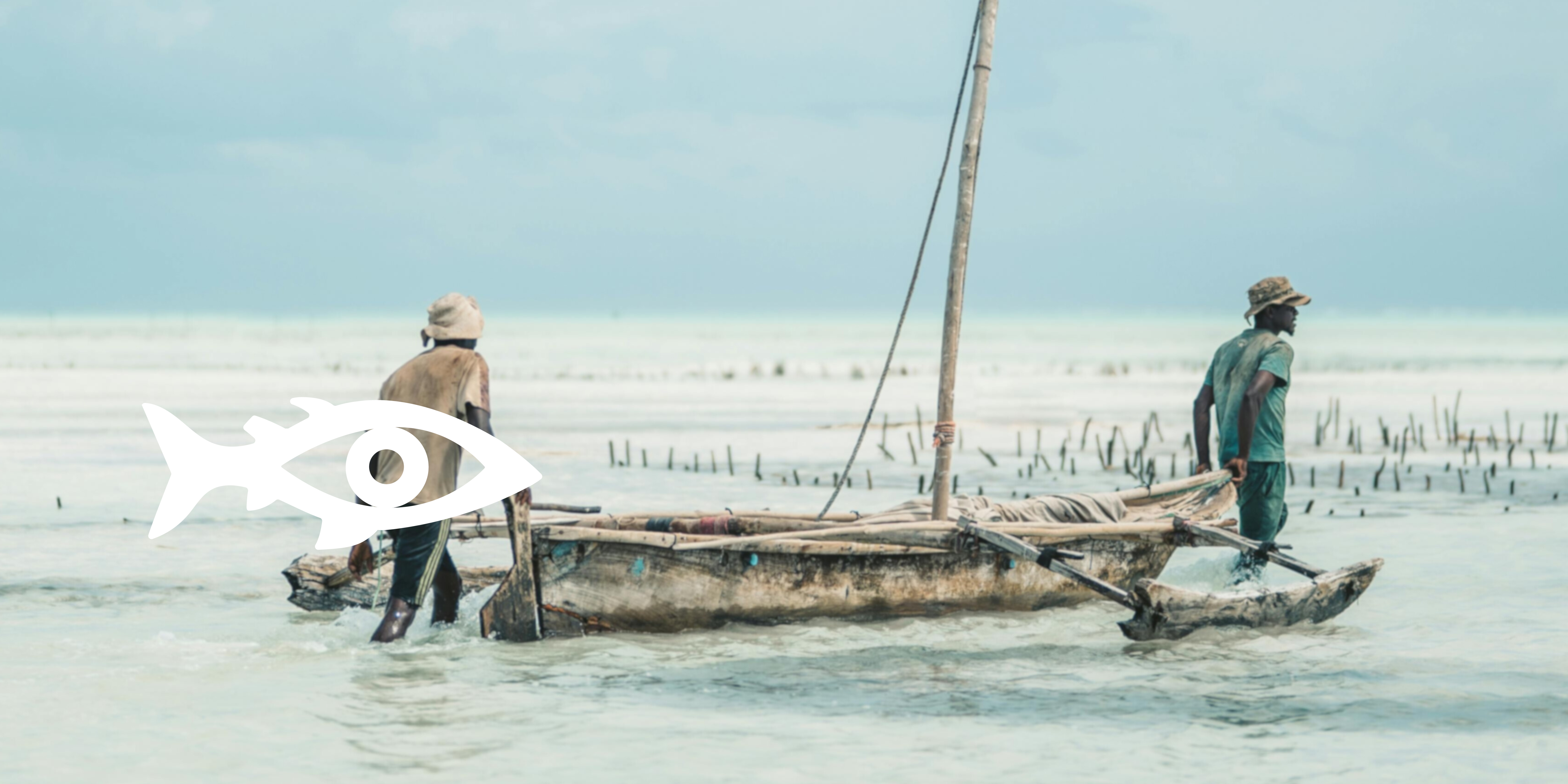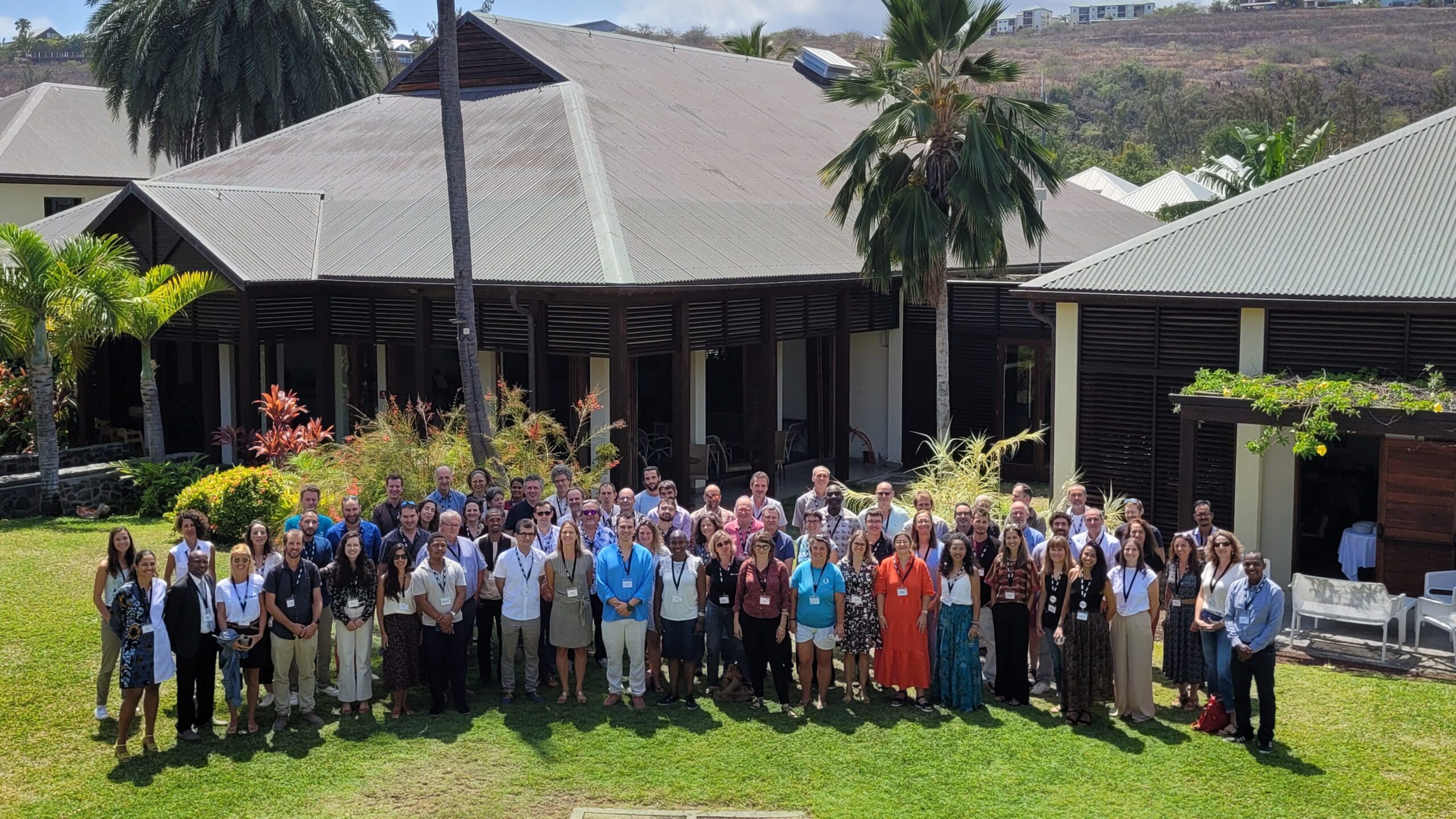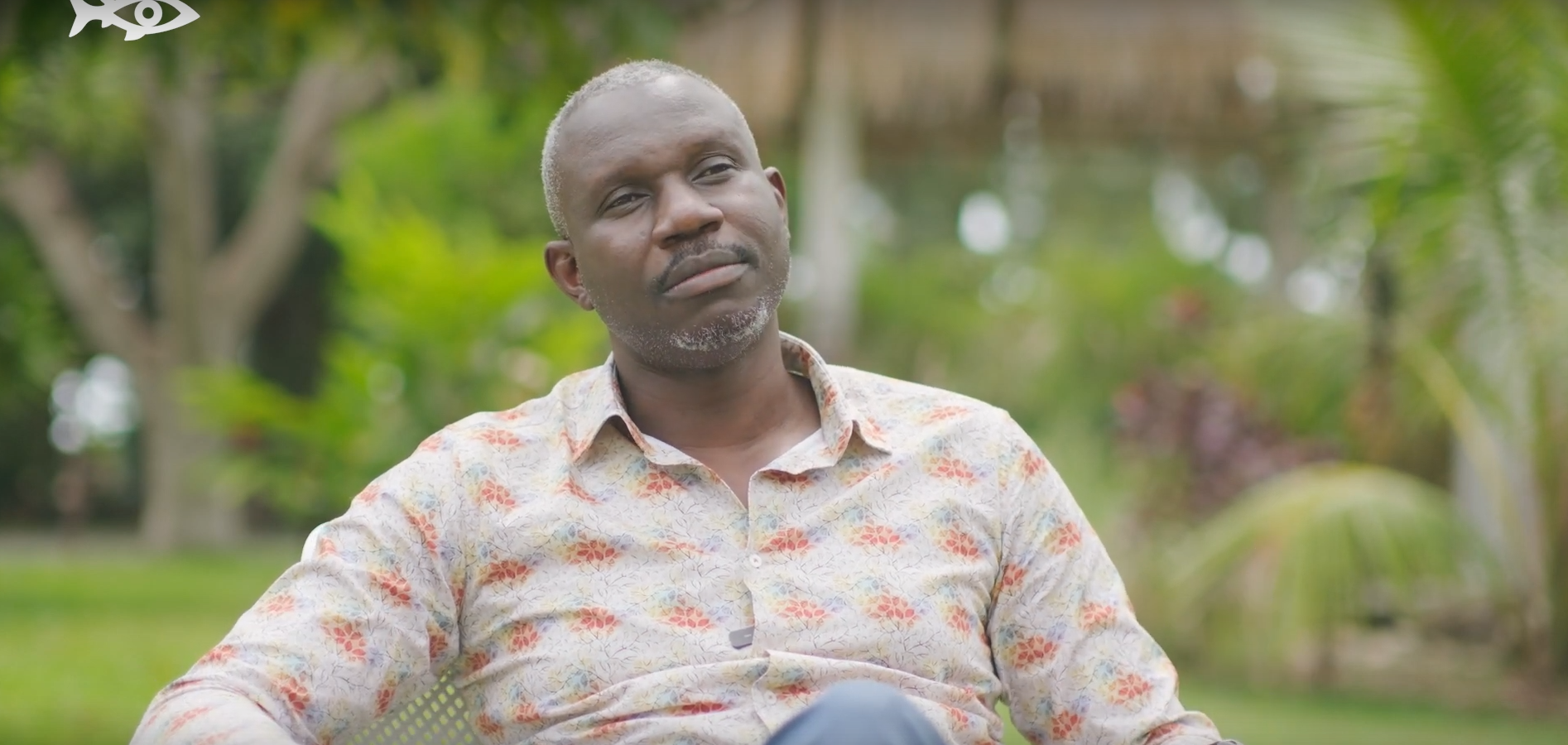
BRIDGES Interviews #2 – Arthur Tuda
Science, connectivity, and leadership: a vision for the western Indian Ocean
BRIDGES launches a series of interviews with key scientific figures. In these videos, they discuss key topics for the Program and outline the actions that need to be taken to achieve the shared ocean we desire.
Interview with Arthur Tuda, Executive Director of WIOMSA (Western Indian Ocean Marine Science Association) and member of the BRIDGES Scientific Advisory Board
In this interview, Arthur Tuda discusses the major ecological, scientific, political, and human issues that are shaping marine governance in the southwestern Indian Ocean today. He highlights the importance of science that is connected to the needs of managers and territories, collaborative approaches to strengthen the effectiveness of shared ocean management, and the need to train a new generation of actors and leaders capable of addressing complex challenges, both present and future. This vision resonates with the approach of the BRIDGES program.
WIOMSA : bringing together the scientific community and supporting integrated ocean management
Created in 1993, the Western Indian Ocean Marine Science Association (WIOMSA) is a regional non-profit organization that promotes scientific research applied to the sustainable management of marine resources in the Western Indian Ocean (WIO). It brings together numerous scientific, managers, institutional, academic, and NGO stakeholders. It runs funding programs for research and young researchers and publishes the Western Indian Ocean Journal of Marine Science. WIOMSA is a bridgehead for networks such as ECSN (young researchers) and WiMS (women in marine science), helping to disseminate knowledge and strengthen the inclusiveness of research in the WIO. WIOMSA promotes science-policy dialogue and supports marine protected area managers through WIOMPAN (marine protected areas management professionals).
Ecological and institutional connectivity: a lever for the resilience of marine systems
Ecological spatial connectivity refers to the biological and physical processes that link spatially distinct areas in the marine environment in ways that are crucial to the life of organisms, populations, ecological communities, and ecosystems (Carr et al., 2017). Protecting ecological connectivity is essential for promoting biodiversity and fisheries conservation (Fontoura et al., 2022).
Arthur Tuda emphasizes the importance of ensuring this ecological connectivity in the region, but also of strengthening social and political connectivity. In his view, it is necessary to ensure stronger inter-state coordination and to connect the various existing modes of governance in order to achieve greater coherence, resilience, and effectiveness in local and regional marine policies.
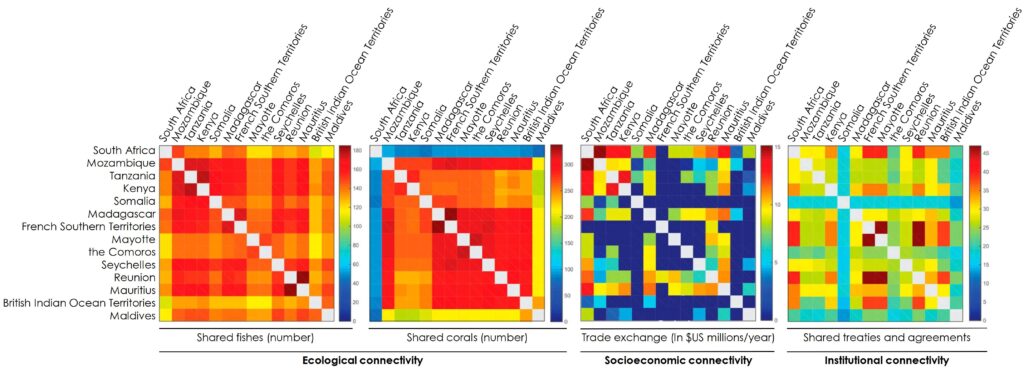
Figure 1: Connectivity matrices in the southwestern Indian Ocean (modified from Levin et al., 2018). In the southwestern Indian Ocean, resources and habitats are highly interconnected (warm colors in the ecological connectivity matrices), but the nodes (i.e., territories) of social and institutional networks are not (cool colors in the socioeconomic and institutional connectivity matrices).
Training tomorrow’s leaders to respond to the complexity of coastal challenges
The complexity of the challenges facing our societies—climate change, pressures related to growing demand for resources, vulnerabilities, inequalities in access to the ocean—requires a transformation in decision-making methods. For Arthur Tuda, this requires the emergence of “blue leaders”, experts, scientists, and decision-makers who are capable of understanding and proposing solutions in dynamic contexts.
This vision is in line with that of the BRIDGES program, which has made capacity sharing a central focus of its activities. Through this component, BRIDGES supports academic training with a regional master’s degree focused on a socio-ecological approach to coastal environments and field schools where students can learn from the reality of the field. The program also plans to launch a call for two interdisciplinary thesis clusters aimed at supporting a new generation of ocean actors who will contribute to the sustainability and resilience of the southwestern Indian Ocean from different positions and sectors.
A first BRIDGES x WIOMSA school in 2025
With this in mind, BRIDGES and WIOMSA will organize their first joint school from September 22 to 26, 2025. This school will bring together around 20 stakeholders from the region to discuss interdisciplinary approaches to strengthening coastal resilience. This school is the first in a long series planned throughout the duration of the Program (2023-2033).
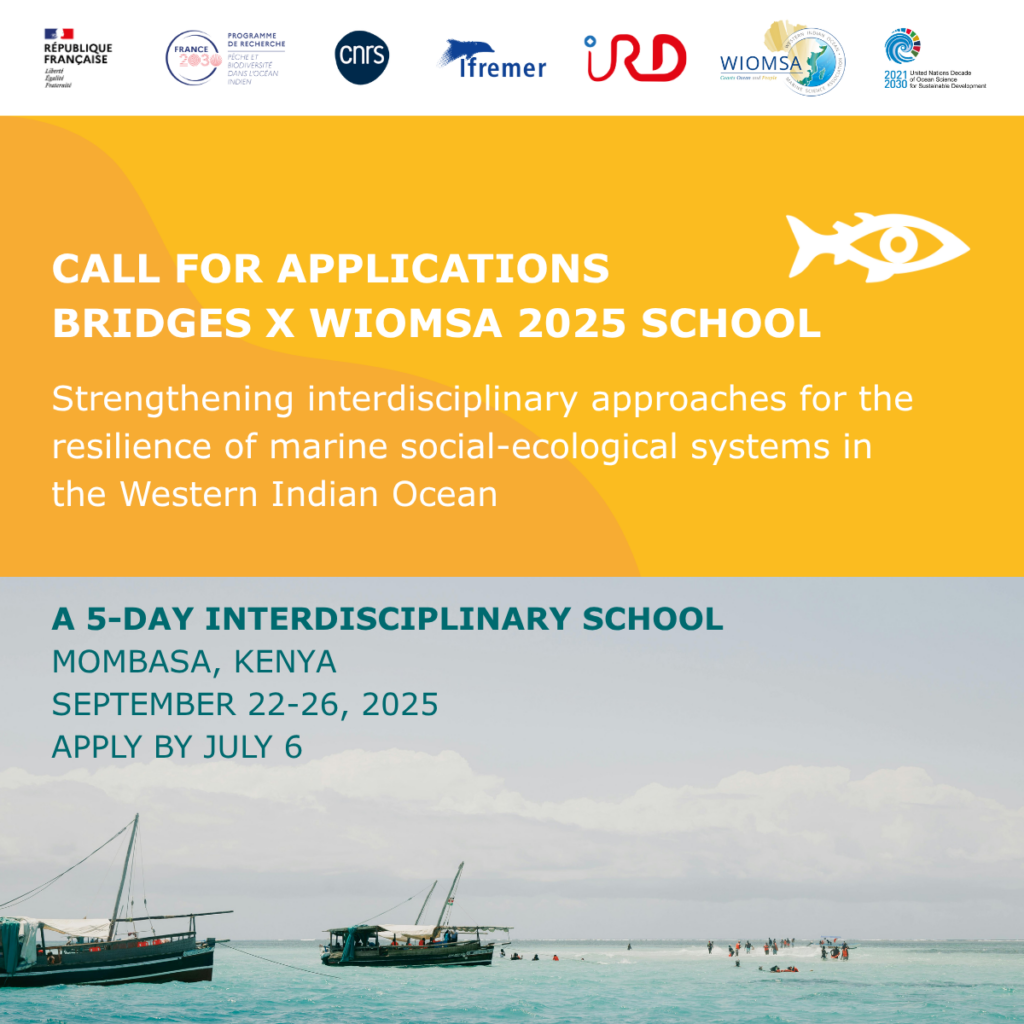
References
Carr, M. H., Robinson, S. P., Wahle, C., Davis, G., Kroll, S., Murray, S., Schumacker, E. J., & Williams, M. (2017). The central importance of ecological spatial connectivity to effective coastal marine protected areas and to meeting the challenges of climate change in the marine environment. Aquatic Conservation Marine And Freshwater Ecosystems, 27(S1), 6‑29. https://doi.org/10.1002/aqc.2800
Fontoura, L., D’Agata, S., Gamoyo, M., Barneche, D. R., Luiz, O. J., Madin, E. M. P., Eggertsen, L., & Maina, J. M. (2022). Protecting connectivity promotes successful biodiversity and fisheries conservation. Science, 375(6578), 336‑340. https://doi.org/10.1126/science.abg4351
Levin, N., Beger, M., Maina, J., McClanahan, T., & Kark, S. (2018). Evaluating the potential for transboundary management of marine biodiversity in the Western Indian Ocean. Australasian Journal Of Environmental Management, 25(1), 62‑85. https://doi.org/10.1080/14486563.2017.1417167
More news News

